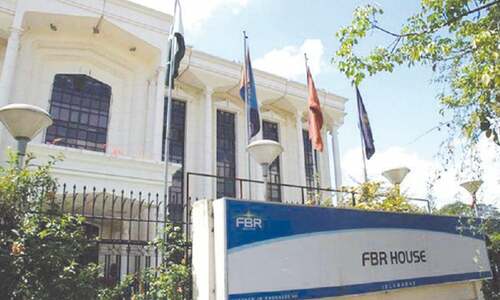 The rupee remained under pressure in the local currency market, as importers continued dollar buying to cover their payment needs.
The rupee remained under pressure in the local currency market, as importers continued dollar buying to cover their payment needs.
It commenced the week on negative note with currency players observing all round decline in the rupee/dollar parity in the interbank market, where the rupee touched three-year lows since October 2004, changing hands at Rs61.34 and Rs61.36 after shedding 22paisa against the dollar on December 3.
The rupee had closed last week at Rs61.12 and Rs61.14. On December 4, however, the rupee showed a turnaround against the dollar, as it managed to recover from the overnight weakness, despite the higher demand for the US currency.
It gained four paisa and traded at Rs61.30 and Rs61.32 on the second day of the week in review.
On December 5, the rupee held its overnight levels against dollar which traded unchanged at Rs61.30 and Rs61.32 for the second consecutive day.
On December 6, the rupee continued its upward rising trend versus the dollar for the third day in a row, as it recovered nine paisa and traded at Rs61.21 and Rs61.23 after the central bank move to slash Special Cash Reserves requirement to 5pc in a move to improve the US currency supply in the interbank market.
The bank has been playing its role to support local currency from falling drastically against the dollar since past month.
On December 7, the rupee failed to hold its firmness in the interbank market.
It drifted lower against dollar due to higher demand and shed two paisa, changing hands against the dollar at Rs61.23 and Rs61.25.
During the week in review, the rupee/dollar parity remained under pressure. The central bank support, however, restricted the rupee from touching new lows against the dollar and lost only eleven paisa.
In the open market, the rupee shed five paisa against dollar on December 3, when it traded at Rs61.40 and Rs61.50 as compared to last week close of Rs61.35 and Rs61.45.
The rupee extended its overnight firmness on the second day of the week in review, gaining five paisa more to trade at Rs61.35 and Rs61.45 against the dollar on December 4.
However, on December 5, the rupee failed to maintain its past two days strength versus the dollar and shed five paisa against dollar at Rs61.35 and Rs61.45. it continued its overnight weakness against the dollar, shedding five paisa for buying and selling at 61.40 and 61.50 on December 6.
On December 7, the rupee continued its downtrend over the American currency and lost five paisa more to trade at Rs61.45 and Rs61.55.
This week, the rupee in the open market remained under pressure but lost only ten paisa amid sharp fluctuations over the previous week.
The central bank measures to restrict the rupee from sharp declines against the dollar proved fruitful.
Versus the European Single common currency, the rupee lost 13 paisa and traded at Rs90.03 and Rs90.13 on the first trading day after closing previous week at Rs89.90 and Rs90.
The rupee continued its downtrend on the second day and shed two paisa versus euro changing hands at Rs90.05 and Rs90.15 on December 4.
On December 5, the rupee continued to weaken against the euro.
It suffered a sharp fall of 30 paisa and traded at Rs90.35 and Rs90.45 as the single European currency started recovering versus the major currencies in the world market.
On December 6, the rupee, however, picked up 80 paisa in relation to the euro after the dollar’s strength forced the euro to face depreciation in the world markets.
At the close of the day, the euro was at Rs89.55 and 89.65. On December 7, the rupee traded unchanged its overnight levels of Rs89.55 and Rs89.65.
During this week, the rupee managed to recover 35 paisa against the European single common currency, despite wide fluctuations.
In the international financial market, the yen rose broadly in quiet trade as continued uncertainty over the fallout from the US credit market turmoil caused investors to reduce exposure to risky carry trades.
In New York, the dollar was down 0.6pc at 110.48 yen, having tripped to a session low of 110.14 on December 3.
The dollar rose to 111.23 at the previous week close, its highest level since mid-November. Sterling rose versus 0.4pc at $2.0651.
The euro rose 0.2pc to $1.4664, still about 3 cents below November’s record peaks but recovering some ground after posting its biggest weekly percentage fall in more than three months.
The dollar dipped 0.5pc to 1.1267 against the Swiss franc. The high-yielding Australian dollar fell 0.4pc to US $0.8801.
Last week, the dollar rose 1.5pc versus a basket of currencies - its biggest weekly gain since June 2006 - after comments by top Federal Reserve officials cemented expectations for interest rate cuts next week and in 2008.
On December 4, the dollar fell against the yen and the euro on speculation the Federal Reserve could cut interest rates aggressively next week to calm market concerns over the credit turmoil and tightening liquidity.
This follows a surprise interest rate cut by the Bank of Canada, which heightened expectations the Bank of England could also ease monetary policy this week and backed the view that central banks were becoming more worried by the credit crisis.
In New York, the euro was up 0.7pc at $1.4765. The dollar fell 0.7pc to 109.73 yen and dropped 0.9pc to 1.1160 against the Swiss franc, with investors reducing exposure to risk as liquidity tightens ahead of the year-end.
The US dollar jumped to a near 11-week high of C$1.0152 and was last at C$1.0122, up 1.2pc on the day.
The high-yielding Australian dollar fell 0.8pc to US $0.8732. Sterling weakened versus the dollar as a surprise cut in Canadian interest rates prompted investors to step up bets for a policy easing from the Bank of England this week. It traded down 0.3pc at $2.0587.
On December 5, the dollar scaled a one-month peak against a basket of currencies after a robust private jobs report suggested the US labour market remained relatively healthy despite an economic slowdown.
The euro recorded its biggest single-day decline against the dollar since July 2006, with traders saying the market was expecting European Central Bank officials to tone down their rhetoric on inflation.
Against the dollar, the pound sterling fell 1.6pc to $2.0258. The dollar rose to a session peak of 110.96 yen as short-term players took profits on the yen’s rise from the previous two days - a move which had been fuelled by worsening credit market conditions before the usually illiquid year-end. It was trading at 110.94 yen, up 1.1pc on the day.
On December 6, the euro rose against the dollar and yen as European Central Bank President hawkish comments on inflation raised the spectre of an interest rate hike in the euro zone.
The single currency also got a boost from an improvement in risk appetite, with US stocks ending higher after US President announced plans aimed at slowing the tide of homeowner foreclosures and shield the economy from the subprime mortgage crisis.
In New York trade, the euro was trading up 0.2pc at $1.4630, after touching a session high of $1.4652.
Against the yen, the dollar rose 0.3pc to 111.22, lifted by firmer US stocks, but lost ground against the high-yielding Australian and New Zealand currencies.
Sterling earlier fell to a fresh two-month low versus the dollar after the Bank of England cut rates by 25 basis points to 5.50pc. It reversed losses to last trade 0.1pc higher at $2.0262.
At the close of the week on December 7, the dollar edged up against the euro as market players squared positions before the US jobs report, looking for clues on the magnitude of an expected Federal Reserve interest rate cut next week.
The dollar slid from a three-week high against the euro the previous day after the European Central Bank reiterated concerns about the inflation outlook and stirred expectations for higher rates next year..
The dollar has clawed back from record lows hit against the euro last month on rising hopes for a resolution of this year’s credit troubles, helped by news such as a White House plan to limit mortgage defaults.
The euro slipped 0.15pc to $1.4612 but stayed above a three-week low of $1.4525 hit on the previous day before the ECB decision.
The dollar edged up 0.1pc from late US trade to 111.34 yen and was near a three-week high of 111.47 yen hit on December 5. The pound slipped to $2.0242.














































Dear visitor, the comments section is undergoing an overhaul and will return soon.